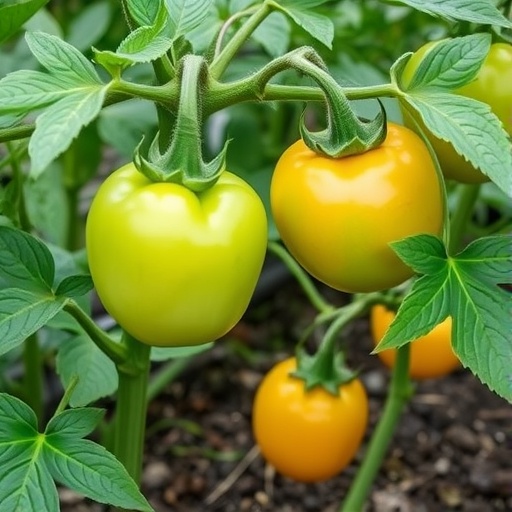Recent advancements in plant pathology have brought to light the intricate dynamics between plant health and pathogenic microorganisms. In a groundbreaking study conducted by Moloto, Mkoyi, and Makhubu, published in Discover Plants, the authors explore the comparative effects of two notable pathogens on several economically significant crops within the Solanaceae family. This research is critical as it highlights the ongoing challenges faced by agricultural sectors that rely heavily on these crops, particularly in the context of climate change and increasing pest resistance.
The study specifically focuses on two pathogens: Pseudomonas syringae pv. syringae and Pectobacterium carotovorum subsp. carotovorum. Both bacteria are known to cause significant damage to various crop species, leading to reduced yields and economic losses. The choice of these particular pathogens stems from their widespread prevalence and devastating impact on crops such as tomatoes, potatoes, and eggplants, which are staples in many diets worldwide.
In the experiment, the researchers inoculated four different Solanaceae species with these pathogens to assess their effects on chlorophyll content and overall plant growth. Chlorophyll is crucial for photosynthesis, and its levels are often indicative of plant health. By measuring chlorophyll levels, the researchers could infer how each pathogen affected the plants’ ability to produce energy and grow, offering insights into the broader implications for crop yields.
Through meticulous experimental design, the study found that the inoculation with Pseudomonas syringae resulted in a marked decline in chlorophyll content across all tested Solanaceae crops. This reduction was significant, indicating that the pathogen directly affects the plants’ physiological mechanisms. Notably, the chlorophyll levels were substantially compromised, thus hampering the plants’ ability to synthesize food effectively. On the other hand, the impact of Pectobacterium carotovorum exhibited a varied response depending on the specific crop species involved.
One particularly alarming discovery was that the adverse effects of Pseudomonas syringae were not uniform across species; certain crops exhibited heightened susceptibility, leading to severe growth impairments. This phenomenon raises critical questions regarding the interactions between specific plant cultivars and pathogens, suggesting that genetic factors might play a substantial role in determining resistance or vulnerability.
Moreover, the study also highlighted the potential for integrating this knowledge into breeding programs aimed at developing more resilient crop varieties. By understanding which species are more susceptible to these pathogens, researchers and agriculturalists can prioritize those varieties for hybridization and genetic improvements, potentially leading to crops that can thrive even in the presence of these harmful bacteria.
In terms of methodology, the researchers employed a combination of qualitative and quantitative analyses to assess plant responses. These included not only chlorophyll measurements but also visual assessments of plant vigor and health. Such a comprehensive approach allowed for a nuanced understanding of each pathogen’s effect on plant growth dynamics.
Furthermore, the broader implications of these findings extend into pest management strategies. As pathogens become more prevalent and aggressive, finding effective control measures becomes increasingly critical. The study emphasizes the need for integrated disease management approaches that consider both biological and chemical controls, ensuring a sustainable future for agriculture.
The research also encourages ongoing studies into other potential microbial interactions that could affect solanaceous crops. Understanding the full spectrum of plant-pathogen interactions can facilitate the development of more targeted interventions, ultimately leading to improved agricultural resilience in the face of evolving challenges.
As agricultural demands continue to rise influenced by a growing global population, the outcomes of this research become ever more significant. By identifying key vulnerabilities and opportunities for improvement in solanaceous crops, researchers can aid in developing strategies that not only protect crops from these specific pathogens but also enhance overall food security.
In conclusion, this pivotal study sheds light on the complexities of plant-pathogen interactions within the Solanaceae family. The findings underscore the importance of continuous research and innovation in agricultural practices, facilitating the breeding of resilient crop varieties and effective management strategies against prevalent pathogens. As we look into the future of agriculture, fostering such advancements will be essential to ensure sustainable food production and to mitigate losses caused by bacterial diseases.
The foundation laid by Moloto, Mkoyi, and Makhubu’s research encapsulates an essential stride in plant pathology studies, highlighting the necessity of understanding the interconnections of biological systems within agriculture. The insights gleaned from this study are crucial for addressing the immediate challenges of crop health and paving the way for a more robust agricultural framework that can withstand the pressures of environmental changes and pathogen outbreaks.
In the ever-evolving landscape of agricultural science, this research serves as a call to action for scientists, agronomists, and farmers alike to collaborate and innovate, ultimately striving towards a sustainable resolution in the quest for global food security.
Subject of Research: The effects of Pseudomonas syringae and Pectobacterium carotovorum on chlorophyll content and growth in Solanaceae crops.
Article Title: Comparison of effects on chlorophyll content and growth between four Solanaceae crops inoculated with Pseudomonas syringae pv. syringae and Pectobacterium carotovorum subsp. carotovorum.
Article References:
Moloto, I., Mkoyi, H.D., Makhubu, F.N. et al. Comparison of effects on chlorophyll content and growth between four Solanaceae crops inoculated with Pseudomonas syringae pv. syringae and Pectobacterium Carotovorum subsp. Carotovorum.
Discov. Plants 2, 338 (2025). https://doi.org/10.1007/s44372-025-00437-4
Image Credits: AI Generated
DOI: https://doi.org/10.1007/s44372-025-00437-4
Keywords: plant pathology, chlorophyll content, Solanaceae, Pseudomonas syringae, Pectobacterium carotovorum, crop resistance, agricultural sustainability.
Tags: bacterial inoculation in agriculturechlorophyll content measurementclimate change and agriculturecrop yield reductioneconomic significance of Solanaceaeeffects of pathogens on plant growthPectobacterium carotovorum effectspest resistance in cropsplant health and microorganismsplant pathology advancementsPseudomonas syringae impactSolanaceae crop health





